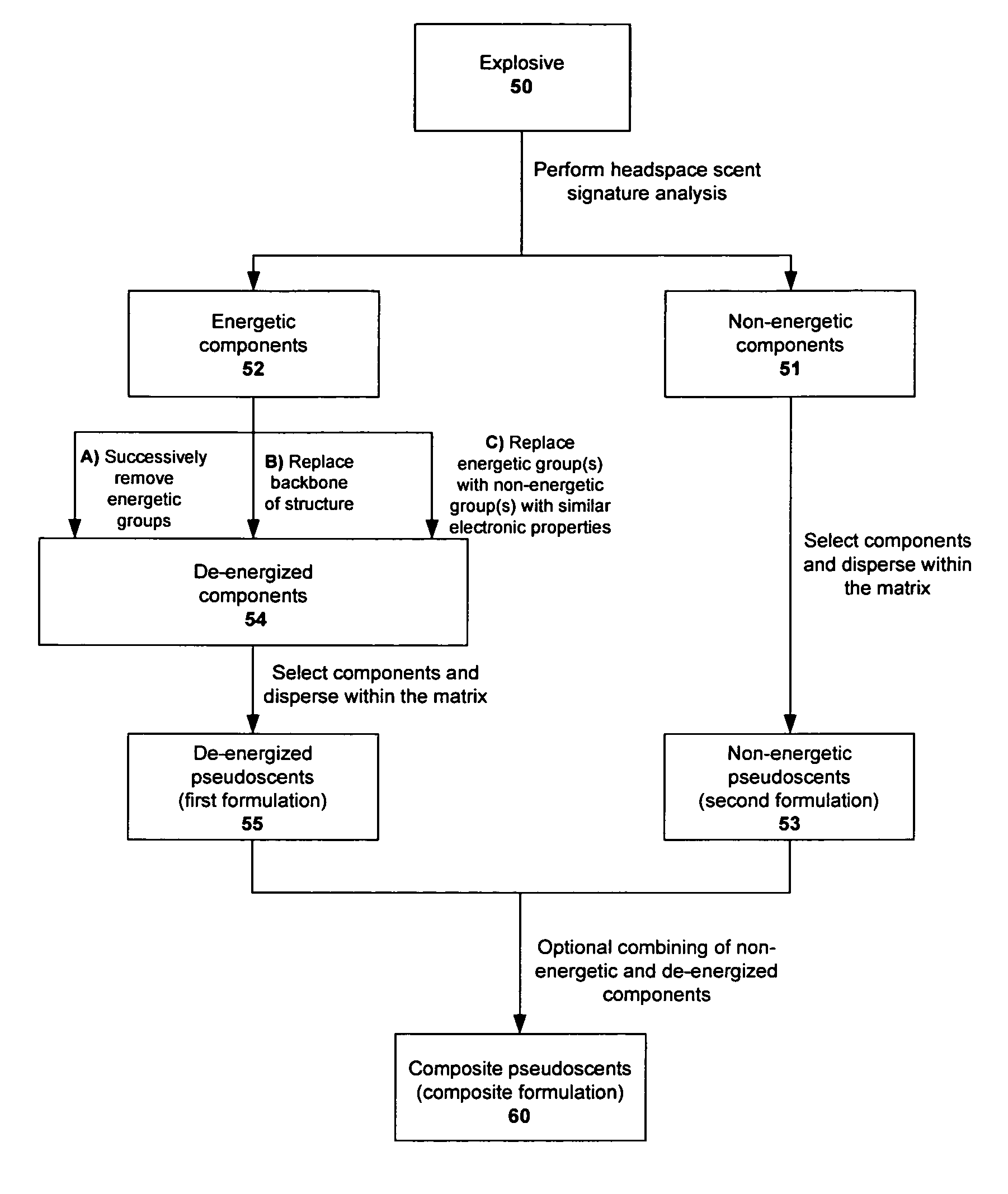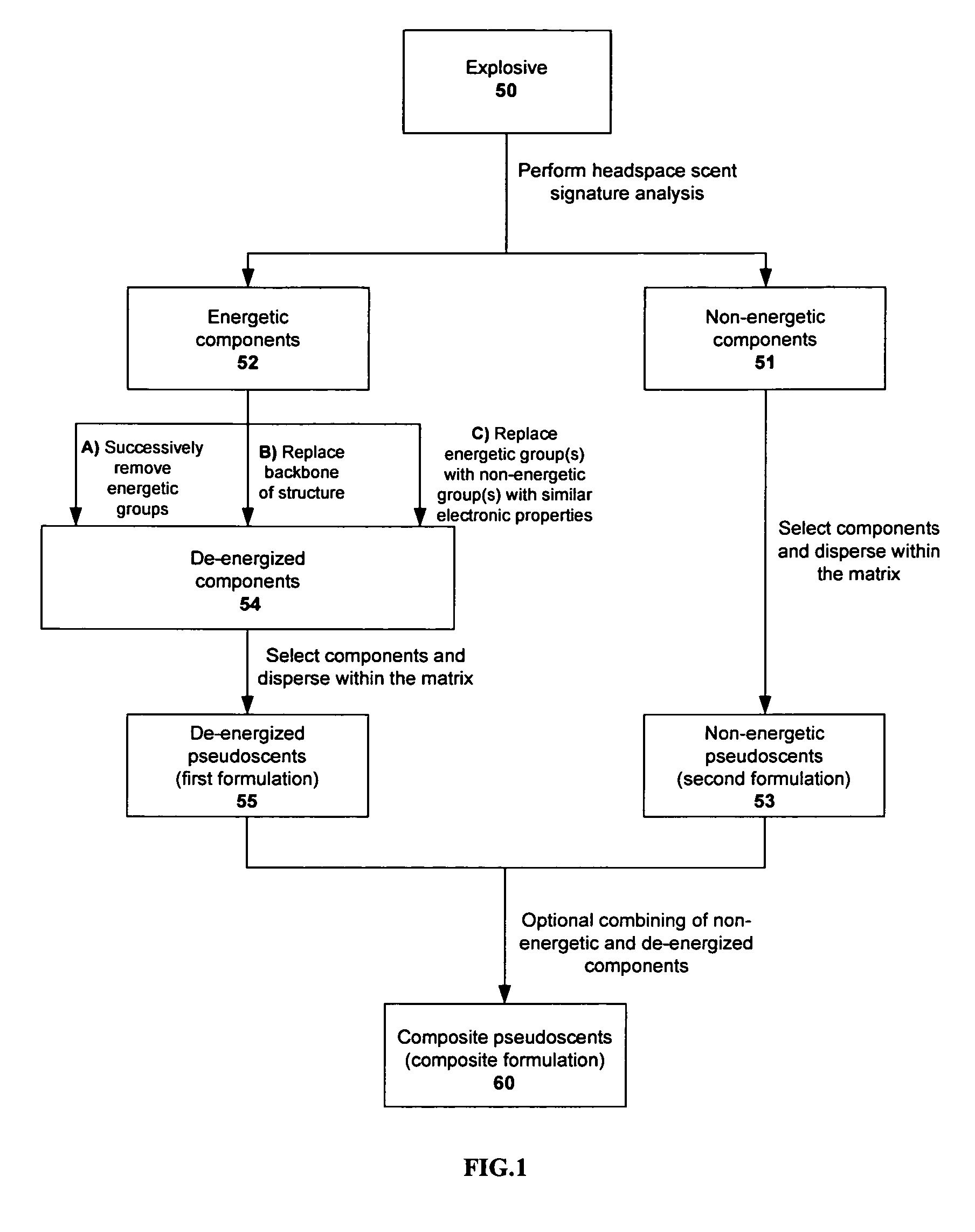Method of producing energetically-inert pseudoscents of explosive materials, and compositions thereof
a technology of explosive materials and pseudoscents, which is applied in the direction of explosives, weaving, looms, etc., can solve the problems of many limitations of the types of scent simulants that can be produced from the direct use of real explosives
- Summary
- Abstract
- Description
- Claims
- Application Information
AI Technical Summary
Benefits of technology
Problems solved by technology
Method used
Image
Examples
example 1
Method of Identifying the Potential Components of a Pseudoscent, and Subsequent Pseudoscent Formulation
[0060]The first stage of identifying the potential candidates for an explosive pseudoscent is to subject the explosive to an analytical method that identifies the components of the headspace scent signature of the explosive. A typical procedure of achieving this through the use of gas chromatography (GC), where the explosive of interest is placed in a flask fitted with a serum cap and allow time for its scent to equilibrate with the air inside the flask. A sample of the scent is then removed from the flask by drawing the air within the flask, into a column that contains an absorbent, using a syringe. After concentrating the scent onto the column, this scent is then desorbed from the adsorbent by heating the column. The desorbed scent travels into the GC column where its components are separated and each of the separated components of the scent are identified. This identification pr...
example 2
Method of Validating (Evaluating) a Pseudoscent, after its Formulation
[0061]For testing the suitability of non-energetic or de-energized components as a potentially useful pseudoscent, a canine search-and-detect methodology has been developed that embraces the best practices in scent detection. The setup comprised of a 7×9 (63-position), or 6×6 (36-position) grid of cardboard boxes, of 1 ft3 in volume and spaced at least 4 ft apart, each of which has a 5 in diameter opening cut out of the topside to allow easy sniffing of the box by canines. Non-energetic components, as determined from headspace analysis of the explosive, were dispersed within inert matrices, put in jars and then randomly placed into each box, through the opening. So were the de-energized equivalents of some energetic components identified within the headspace. Also randomly placed within the test grid were real explosives such as ammonium nitrate, smokeless powder and C4 explosives. These are to be used to benchmar...
example 3
Method of Making an Energetically-Inert Pseudoscent for Dynamite Explosive #1
[0063]Referring to FIG. 1, using GC for headspace characterization, the headspace scent signature of dynamite explosive was found to contain ethylene glycol dinitrate and trinitroglycerine as the primary components. Since both components were energetic materials as defined by 52, they needed to be de-energized before being used within a pseudoscent formulation. Thus, with the intention of forming a single-component pseudoscent for dynamite, the nitro groups within the molecular structure of trinitroglycerine were replaced with the acetate functional group, forming glycerol triacetate. The acetate group has similar electron withdrawing properties as the nitro group, and is therefore deemed odoriferously equivalent. A pseudoscent of dynamite of the type represented by 55 was then formed by dispersing 5.40 g (100%, active ingredient), glycerol triacetate in 10 g of diatomaceous earth to produce a training aid ...
PUM
 Login to View More
Login to View More Abstract
Description
Claims
Application Information
 Login to View More
Login to View More - R&D
- Intellectual Property
- Life Sciences
- Materials
- Tech Scout
- Unparalleled Data Quality
- Higher Quality Content
- 60% Fewer Hallucinations
Browse by: Latest US Patents, China's latest patents, Technical Efficacy Thesaurus, Application Domain, Technology Topic, Popular Technical Reports.
© 2025 PatSnap. All rights reserved.Legal|Privacy policy|Modern Slavery Act Transparency Statement|Sitemap|About US| Contact US: help@patsnap.com


